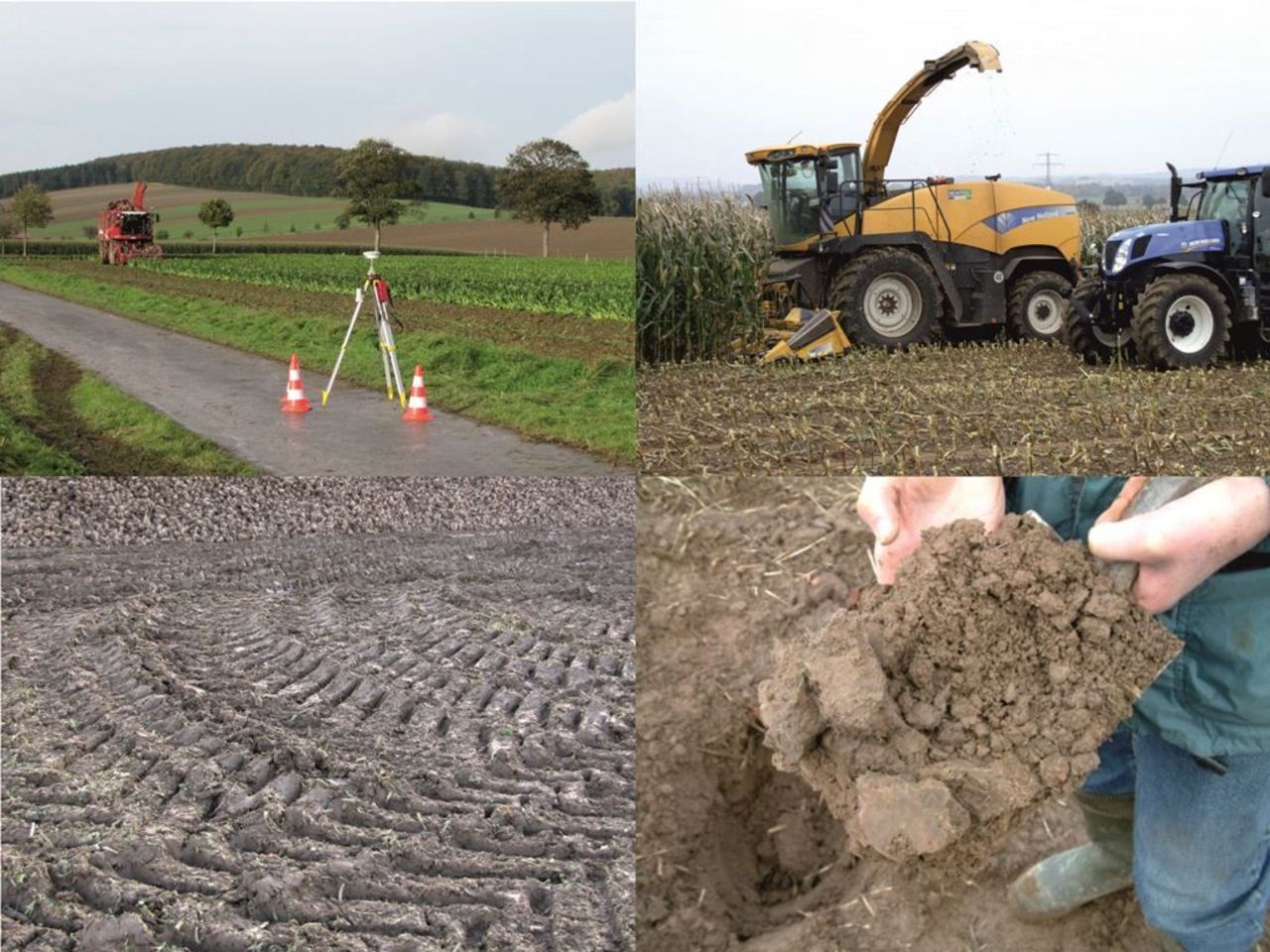Project
SOILAssist

SOILAssist: Sustainable protection and improvement of soil functions with intelligent land management strategies – a practical on the fly assistance system for farmers
SoilAssist is an interdisciplinary research project with the aim of holistic observation of agricultural soil protection during the survey of arable land and to recognize and avoid negative changes in soil structure and functionality at an early stage, as well as to maintain and improve it by means of adapted management. The Thünen Institute for Agricultural Technology is responsible for the coordination of the joint project, the development of the soil model and, in cooperation with the project partners, the development of the real-time assistance system. The Climate and Soil Departments are responsible for the subprojects "Socio-economic analyzes" and "Acceptance and knowledge transfer". The joint project SOILAssist is part of the funding measure BONARES of the Federal Ministry of Education and Research.
In Febuary 2022, after the successful completion of the second phase, the third funding phase of three years began. In the coming years, the work from the second phase will continue and the results, products, tools and models will be finalized. Detailed results can be found on the SOILAssist homepage.
Background and Objective
In the last years and decades the sizes and total weights of agricultural machinery increased more and more. This was primarily for economic and process-efficiency reasons. High specialized machinery requires high operating grades. In adverse conditions, considerable negative changes in soil structure and in multiple soil functions occur. Basically soil functions are affected negatively by intensive agricultural field traffic. Management based negative changes in soil functions still have negative effects on economic and ecological efforts and benefits. For using soils as a sustainable resource for bio-economic purposes (BonaRes), agricultural land use should put a focus on sustainable protection and improvement of soil functions, while keeping the economic conditions in mind. The SOILAssist consortium will put a holistic focus on this area of conflict.
Target Group
Research community, Soil research community, farmers,agricultural contractors, agricultural extensionists, education, Policy makers
Approach
Surveys of multiple passes of agricultural machineries at various points with different soil load in the field (Pressure/deformation measurements, soil physical surveys on undisturbed soil cores, etc.),
Route tracking of machineries on the field etc.
Multi – Sensor - System measurements (deflection, track depth, total weight, inflation pressure, contact area etc.)
Field measurements (penetration resistance, soil moisture, variation in the fields etc.)
Soil surveys (undisturbed soil cores)
Laboratory measurements (changes in soil functions)
Soil modeling (3D – soil pressure , deformation and functionality model)
Field demonstrations, thematic workshops
Questionaires for farmers
Socio-economic evaluation.
Our Research Questions
To what extend does the application of multi-sensor data from minimal and non-invasive measuring platforms enable the prediction of soil compaction effects inside of a field?
What indicators are suited to assess the changes in soil structure and soil functions caused by field traffic? Can we define threshold values for sustainable soil management?
How must optimal agricultural processing chains be designed to maintain / improve soil quality and soil functions?
Can approaches to simulating traffic-induced soil stresses and related effects on soil functions contribute to an “on-board”-assistance system to optimize field management?
What are the economic effects of sustainable field traffic and what are the costs and benefits of soil-adjusted field traffic?
Preliminary Results
To hit this targets, an ‘on the fly’- assistance system for farmers and agricultural contractors will be developed, applied and implemented to optimize the soil conserving traffic on agricultural land and to prevent negative changes in soil functions by optimizing machinery configuration, machinery routes on the field etc. and the overall management.
Additionally, recommendations and recommended actions for farmers, agricultural contractors, agricultural extensionists and political consultancy and an advisory system will be established, to support decision making of farmers for a foresighted planning of soil conserving agricultural management strategies. Moreover, the socio-economic consequences of different management options will be identified and assessed.
Links and Downloads
Thünen-Contact

Involved Thünen-Partners
- Germer, KaiAT Institute of Agricultural Technology
- Jacobs, AnnaKB Coordination Unit Climate and Soil
- Lorenz, MarcoAT Institute of Agricultural Technology
- Osterburg, BernhardKB Coordination Unit Climate and Soil
- Prilop, KarenKB Coordination Unit Climate and Soil
- Siekmann, MaikeAT Institute of Agricultural Technology
Involved external Thünen-Partners
- Christian-Albrechts-Universität zu Kiel
(Kiel, Deutschland) - Deutsches Forschungszentrum für künstliche Intelligenz (DFKI), Robotics Innovation Center
(Osnabrück, Deutschland) -
Universität Osnabrück
(Osnabrück, Deutschland)
Funding Body
-
Federal Ministry of Education and Research (BMBF)
(national, öffentlich)
Duration
8.2015 - 1.2025
More Information
Project status:
ongoing
Publications on the project
- 0
Dittmann D, Seelig AH, Thalmann M, Wilkes T, Junghans V, Zahn D, Klitzke S, Peters A, Haberkamp J, Ruhl AS (2024) Potential and risks of water reuse in Brandenburg (Germany) - an interdisciplinary case study. Water Reuse 14(1):1-15, DOI:10.2166/wrd.2024.081
- 1
Peters A, Iden SC, Durner W (2023) Prediction of absolute unsaturated hydraulic conductivity - comparison of four different capillary bundle models. Hydrol Earth Syst Sci 27(24):4579-4593, DOI:10.5194/hess-27-4579-2023
- 2
Ledermüller S, Prilop K, Jacobs A (2022) Befragungsergebnisse: Bodenschonende Maßnahmen und neue Technologien in Lohnunternehmen : Thünen-Institut befragt Lohnunternehmen. LU-aktuell 2022(7):30-32
- 3
Brunotte J, Lorenz M, Weise M (2021) Boden schonen trotz enger Zeitfenster. DLG Mitt(2):70-73
- 4
Brunotte J, Lorenz M, Weise M (2021) Bodenschonend fahren - aber wann? Eilbote 69(14):10-13
- 5
Ledermüller S, Brunotte J, Lorenz M, Osterburg B (2020) Arbeitsbericht: Verbesserung des physikalischen Bodenschutzes bei der Wirtschaftsdüngerausbringung im Frühjahr - Herausforderungen und Lösungsansätze. Halle (Saale): BonaRes-Zentrum für Bodenforschung, 30 p, BonaRes Series, DOI:10.20387/BonaRes-ESZ2-NRV9
- 6
Techen A-K, Helming K, Brüggemann N, Veldkamp E, Reinhold-Hurek B, Lorenz M, Bartke S, Heinrich U, Amelung W, Augustin K, Boy J, Corre MD, Duttmann R, Gebbers R, Gentsch N, Grosch R, Guggenberger G, Kern J, Kiese R, Kuhwald M, et al (2020) Chapter Four - Soil research challenges in response to emerging agricultural soil management practices. Adv Agron 161:179-240, DOI:10.1016/bs.agron.2020.01.002
- 7
Kuhwald M, Hamer WB, Brunotte J, Duttmann R (2020) Soil penetration resistance after one-time inversion tillage: a spatio-temporal analysis at the field scale. Land 9(12):482, DOI:10.3390/land9120482
- 8
Augustin K, Kuhwald M, Brunotte J, Duttmann R (2020) Wheel load and wheel pass frequency as indicators for soil compaction risk: A four-year analysis of traffic intensity at field scale. Geosci 10(8):292, DOI:10.3390/geosciences10080292
- 9
Augustin K, Kuhwald M, Brunotte J, Duttmann R (2019) FiTraM: A model for automated spatial analyses of wheel load, soil stress and wheel pass frequency at field scale. Biosyst Eng 180:108-120, DOI:10.1016/j.biosystemseng.2019.01.019
- 10
Ledermüller S, Lorenz M, Brunotte J, Fröba N (2018) A multi-data approach for spatial risk assessment of topsoil compaction on arable sites. Sustainability 10(8):2915, DOI:10.3390/su10082915
- 11
Brunotte J, Lorenz M, Senger M, Epperlein J (2018) Chapter II/15: A simple soil structure assessment for the farmer. In: Sychev VG, Mueller L (eds) Novel methods and results of landscape research in Europe, Central Asia and Siberia : Monograph in 5 Volumes ; Vol. II Understanding and monitoring processes in soils and water bodies. Moscow: FGBNU "VNII agrochimii", pp 74-78, DOI:10.25680/6680.2018.72.78.112
- 12
Brunotte J, Duttmann R, Augustin K, Kuhwald M (2018) Chapter II/60: Analysis and modeling of field traffic intensity in farming landscapes using gis. In: Sychev VG, Mueller L (eds) Novel methods and results of landscape research in Europe, Central Asia and Siberia : Monograph in 5 Volumes ; Vol. II Understanding and monitoring processes in soils and water bodies. Moscow: FGBNU "VNII agrochimii", pp 279-284, DOI:10.25680/2112.2018.56.77.157
- 13
Lorenz M, Brunotte J, Fröba N, Löpmeier F-J (2018) Chapter IV/20: Principles of soil conserving traffic on arable land - adaption of load input by agricultural machines to the susceptibility of soil to compaction. In: Sychev VG, Mueller L (eds) Novel methods and results of landscape research in Europe, Central Asia and Siberia : Monograph in 5 Volumes ; Vol. IV Optimising agricultural landscapes. Moscow: FGBNU "VNII agrochimii", pp 101-106, DOI:10.25680/1281.2018.93.92.285
- 14
Kuhwald M, Blaschek M, Brunotte J, Duttmann R (2017) Comparing soil physical properties from continuous conventional tillage with long-term reduced tillage affected by one-time inversion. Soil Use Manag 33:611-619, DOI:10.1111/sum.12372
- 15
Brunotte J, Lorenz M (2017) Optimierter Maschineneinsatz für eine bodenschonende Silomaisernte : Anpassung der mechanischen Belastung an die Verdichtungsempfindlichkeit von Böden. Mais 44(4):176-180
- 16
Lorenz M, Brunotte J, Fröba N (2017) Optimierter Maschineneinsatz schont den Boden : Anpassung der Lasteinträge landwirtschaftlicher Maschinen an die Verdichtungsempfindlichkeit des Bodens. Landwirtsch Ohne Pflug 22(12):36-41
- 17
Lorenz M, Brunotte J, Vorderbrügge T, Brandhuber R, Koch HJ, Senger M, Fröba N, Löpmeier F-J (2016) Anpassung der Lasteinträge landwirtschaftlicher Maschinen an die Verdichtungsempfindlichkeit des Bodens - Grundlagen für ein bodenschonendes Befahren von Ackerland. Landbauforsch Appl Agric Forestry Res 66(2):101-144, DOI:10.3220/LBF1473334823000

![[Translate to English:] Logo des Bundesministerium für Ernährung und Landwirtschaft](/media/allgemein/logos/BMEL_Logo.svg)